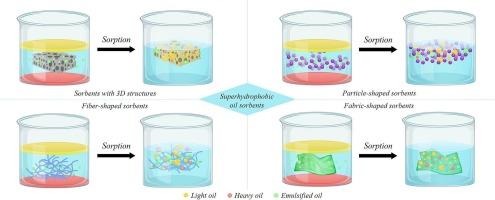用于含油废水处理和溢油清理的超疏水和超亲油吸附剂的结构分类和性能分析:综述
IF 9.2
2区 工程技术
Q1 ENERGY & FUELS
引用次数: 0
摘要
近年来,由于石油泄漏事故和含油工业废弃物的出现,溢油处理已成为一个重要的问题,相关文章层出不穷。然而,大多数溢油清理方法都有其局限性,应选择适合海水的溢油清理方法。一种适用于海水的方法是使用吸油剂/吸附剂,但大多数吸油剂对石油的选择性较低,这意味着它们不能完全清洁海水或使收集的石油可重复使用。因此,本文对超疏水吸附剂处理溢油的研究进展进行了综述。超疏水吸附剂由于具有较强的拒水能力,对油具有较高的选择性。此外,一些超疏水吸附剂可以吸附水中的乳化油。因此,这种类型的吸收剂/吸附剂将降低最终成本和环境影响。本文对以往的研究进行了综述,并对其优缺点进行了分析,以帮助未来的研究人员找到更深入、更深入的研究灵感。本文在引言部分讨论了溢油清理的紧迫性,并比较了超疏水吸附剂与其他处理方法的优越性。第2节提供了关于超疏水吸附剂的耐久性、选择性、物理结构、化学性质、可重复使用性、机械稳定性等信息。第3节比较了吸附剂/吸附剂的物理结构。最后,在第4节中,根据以前的出版物提出了一些研究机会和想法。本文章由计算机程序翻译,如有差异,请以英文原文为准。

Structure-based classification and performance analysis of superhydrophobic and superoleophilic oil absorbents/adsorbents for oily wastewater treatment and oil spill cleanup: A comprehensive review
Recently, oil spill treatment has become a significant issue due to oil leakage accidents and oily industrial wastes, resulting in numerous articles being published. However, most approaches for oil spillage cleanup have limitations, and the cleaning method should be suitable for seawater. One applicable method in seawater is employing oil absorbents/adsorbents, but most of them have low selectivity for oil, meaning they will not completely clean the water or make the collected oil reusable. Accordingly, in this review, the works aiming for oil spillage treatment using superhydrophobic absorbents/adsorbents have been reviewed. Superhydrophobic absorbents/adsorbents, due to their strong water-repelling ability, have high selectivity for oil. Moreover, some superhydrophobic absorbents/adsorbents can absorb/adsorb emulsified oil in water. Consequently, this type of absorbent/adsorbent will reduce final costs and environmental impacts. This review paper provides an overview of previous studies and their pros and cons to help future researchers find inspiration for more advanced and thorough studies. In this review paper, the urgency of oil spill cleanup is discussed in the introduction, and the superiority of employing superhydrophobic absorbents/adsorbents is compared to other types of treatment. Section 2 provides information about superhydrophobic absorbents/adsorbents' durability, selectivity, physical structure, chemical properties, reusability, mechanical stability, etc. The physical structures of the absorbents/adsorbents were compared in Section 3. Finally, in Section 4, some research opportunities and ideas are presented based on previous publications.
求助全文
通过发布文献求助,成功后即可免费获取论文全文。
去求助
来源期刊

Sustainable Materials and Technologies
Energy-Renewable Energy, Sustainability and the Environment
CiteScore
13.40
自引率
4.20%
发文量
158
审稿时长
45 days
期刊介绍:
Sustainable Materials and Technologies (SM&T), an international, cross-disciplinary, fully open access journal published by Elsevier, focuses on original full-length research articles and reviews. It covers applied or fundamental science of nano-, micro-, meso-, and macro-scale aspects of materials and technologies for sustainable development. SM&T gives special attention to contributions that bridge the knowledge gap between materials and system designs.
 求助内容:
求助内容: 应助结果提醒方式:
应助结果提醒方式:


